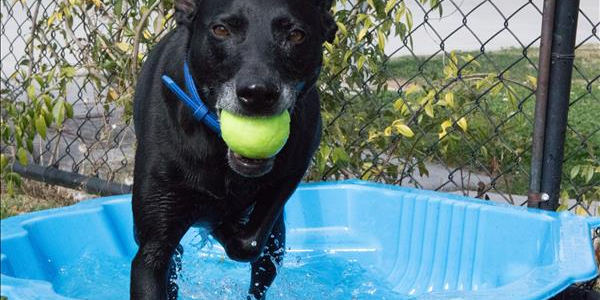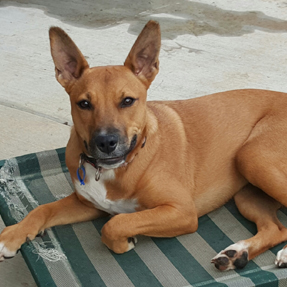TIPS FOR YOUR DOG:
Dogs don’t sweat. Cooling occurs through panting (evaporative cooling from the lungs and mouth), lying on a cool surface and drinking cool water. Hot weather paired with high humidity are the most dangerous days for dogs as cooling through panting is not as efficient in these weather conditions. Therefore, always ensure that your pet’s water bowl is checked on a regular basis and they always have access to clean, fresh water. In the event that you are out, ensure that the bowl is big enough to hold enough water for the whole day. In case of a tip-over, leave two or three water bowls – just in case! You could also pop in a few ice cubes to keep the water nice and cold. Check out our World for Pets website to view the various bowls available.
Shade for the day. If your pet is in the backyard during the day, ensure they have plenty of access to shade – remember the sun moves throughout the day – so ensure your pet has shade from all aspects throughout the day. Pets can suffer heatstroke or even death in their own backyard on a hot Summer’s day without shade or water. Dog houses do not provide adequate ventilation; your dog can end up being in a ‘hot box’, which can make matters even worse. During a heat wave (or extreme temperatures), it is best to have your dog inside in a well-ventilated area, which will give them a break from the scorching sun.
Sleeping spots. Dogs will normally find the coolest spot of the house or yard themselves, but place outside beds or mats in shady or cool spots. Try dampening your dog’s blankets or mats with water to create cool resting spots, or you can also buy cool mats and cool jackets specifically for dogs. See our RSPCA World for Pets website for cool mats and jackets for your pet.
Bubble bath! When the heat soars take the opportunity to give your pet a bath with lukewarm water. This will instantly cool them down and prevent any overheating. See the World for Pets website for a list of pet-friendly shampoos and conditioners.
Doggy paddle! Not all dogs know how to swim! If you have a backyard pool, ensure it is adequately fenced and your dog knows how to swim. Teach your dog to swim to a certain point at the edge of the pool where the stairs are. You can even get a doggy ladder to make the swimming experience easier for your pooch. Or get a small paddle pool (with shallow water) to keep them cool in summer (also makes a great extra water bowl!)
Pupsicles! Frozen treats in a treat dispenser or kong or even cupcake liners are a great way to cool down your dog and keep them occupied. Get creative in the kitchen! There are many simple recipes to keep your dog cool this summer. Check out a list of kongs and treat toys available at our World for Pets website. Pet popsicles are a great treat and can be made out of all kinds of things your dog (or cats) eat normally, so experiment to see what they like best!
Let’s go walking! It is essential that your dog gets a regular walk. However, always be mindful of the intensity of the summer heat and the terrible effects the heat can have on your dog. Remember sunrise and sunset are the most ideal times for a walk. Try to walk on grass rather than hot concrete as this can burn your pooch’s paw pads. Also ensure that you always carry a water bottle and a bowl to prevent your dog from getting dehydrated.
Slip Slop Slap for your Pet! Dogs and cats with smooth/thin hair and white-coloured ears or noses can be more susceptible to skin cancers, so be mindful of this when the sun is out. To ensure that your dog doesn’t get sunburnt, keep your pet out of the sun in the hottest hours of the day and consider sunscreen from our World for Pets website.
Watch out! Heat stress can sometimes be more prevalent as a result of the animal’s physiological attributes. Brachycephalic (flat face) breeds, such as pugs, boxers, bulldogs, terries and cavalier king charles spaniels are far more susceptible to heat stress than other breeds. This is due to the fact that dogs naturally reduce their body temperature by panting (evaporative cooling from the lungs and mouth). Brachycephalic breeds have shortened airways which reduces the effectiveness of panting. The weather does not even have to be particularly hot for these breeds to develop symptoms of heat stress.
Dogs in Hot Cars Each year, the RSPCA receives hundreds of distress calls about animals (usually dogs) being left in cars in the heat. Never leave your dog unattended in a car. Find out what you can do if you see a pet in a hot car here.
TIPS FOR YOUR CAT:
Cats will generally find a place to keep themselves cool in the heat. It is helpful to make sure their water is in the shade or inside and convenient. You can leave a fan on indoors or put down some wet towels and cats will use them if they choose to. You will find cats won't be too active in the heat and find a cool place to nap.
Cats can suffer heat stress if they get caught outside in the sun or use up energy (e.g. running or playing). Watch for signs of heat stress such as panting and excessive salivation. If you see such signs, make sure your cat is in the coolest part of the house and use a wet cloth and dampen the fur. Do not try and dunk your cat in water because that will usually add to the stress.
To keep your cat safe from skin cancer, keep white cats or cats with light pigmentation indoors. You can also check out our RSPCA World for Pets website for sunscreen for these types of cats.To learn more about safely keeping your cat confined inside see the RSPCA National website.
TIPS FOR SMALLER ANIMALS:
Guinea pigs are very susceptible to heat stress. You should ensure that your guinea pig’s hutch remains shaded the entire day. A good supply of drinking water should be available and an ice brick wrapped in a tea towel placed in the pen.
Fish get hot too! Did you know that in warm weather your fish can get hot too? Remember to watch your fish for signs of distress. This could be if they are gasping for breath or if they seem paler in colour. For tropical fish you may want to turn off the water heater and monitor the temperature closely to keep its ideal level. You can cool your fish tank by having a fan blow across the surface. For tropical fish anything over 30 degrees is too hot. For goldfish the water temperature shouldn’t be higher than about 28 degrees. If the fan option doesn’t cool the water temperature you can freeze some water in a container or bag and place it in the tank or near the filter area. Remember to gradually change your water temperature so you don’t shock your fish. Let’s look after our scaly friends!
Pet Birds can feel the heat as well. Make sure their cages are in the shade with good ventilation. Outside aviaries should offer good shade, and when it is really hot smaller cages should be brought inside. Birds need a good supply of fresh water too.
TIPS FOR LIVESTOCK:
For chooks ensure they have access to plenty of shade, large containers of water in the shade and wet the dirt in the shade as they will enjoy rooting in the wet ground. You can also offer them ice blocks in the shade and ice cubes in their water.
For larger livestock species, such as cattle, sheep and goats, ensure they always have access to water and shade. Never move them around unnecessarily in the heat of the day and don’t let dogs worry them either.
Horses should also have access to water and shade during the summer, and they shouldn’t be ridden, trained or worked in high temperatures.
HEAT STRESS SYMPTOMS:
- Panting
- Seeking a cool/shady spot
- Excessive salivation
- Enlarging tongue
- Red gums/lips
- Increasing heart rate
- Anxious or distressed demeanour
- Staggering
If the animal’s high temperature is not relieved the animal’s condition quickly worsens. The animal may start to display more severe symptoms of heat stress which include:
- Very rapid heart rate
- Circulation shutdown
- Trembling/seizures/falling down
- Respiratory distress
- Vomit with blood
- Diarrhoea with blood
- Coma
If an animal has heat stress, prompt action is needed if a positive outcome is to be achieved. First aid measures should be applied quickly and the animal must then be transported to a veterinarian immediately. Never transport an animal while they are still hot. Cooling them down first is essential. Bathing the animal in cool (not cold) water is one of the best ways to cool them down, or apply ice packs to the groin and underarm area, or place them in front of a fan or in an air conditioned room. The animal should also be offered cool, fresh water to bring their temperature down. Once the animal is cool always take them to the vet as they may have internal damage from the heat stress.









